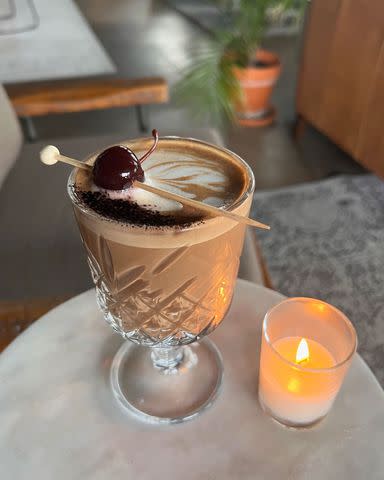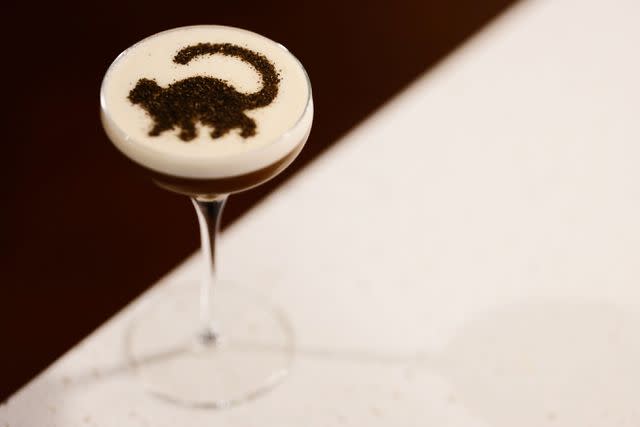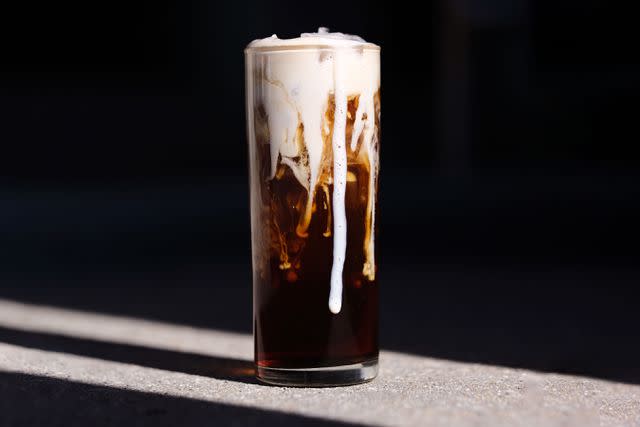The Line Between the Coffee Shop and the Cocktail Bar Has Never Been Blurrier
Baristas are incorporating craft cocktail techniques to make show-stopping coffee drinks.
At Milwaukee’s Discourse Coffee Workshop, you order your caffeinated beverage of choice from a bar loaded with cocktail tools like strainers, jiggers, and bottles of Angostura bitters. Maybe that’s a latte like the Channel Orange, with smoked and oaked vanilla syrup, orange oleo saccharum, and candied orange powder, or the Snowblind, which includes nitro cold brew with vanilla syrup, maple root beer, Bittercube root beer bitters, and oat cream. Discourse Coffee founder Ryan Castelaz’s goal behind his bar’s clever program is to “empower baristas everywhere to dream bigger and feel like they can express themselves through coffee.” He adds, “For so long, this has been an industry determined by volume — you gotta move vanilla lattes, sell more drip. It’s a sensible business model, but baristas are creative and driven, and opening doors for creativity is about empowering people.”
Employing cocktail techniques and ingredients in addition to espresso machines gives baristas a much wider array of tools to work with, and coffee bars are seeing patrons embrace the unique offerings. “Our customers have come to expect wildness from our drinks, and it has created a really special community around creativity in coffee,” Castelaz says. The same is true at Indianapolis’ Parlor Public House, which serves coffee by day and cocktails by night. There, the nitro cold brew goes into the Espresso Martini, while some coffee drinks are served in fluted glassware. Analog Coffee Bar in Newport, Kentucky has a six-seat chef’s table, where baristas offer a la carte beverages made with ingredients like activated charcoal, cocktail cherries, and ginger beer, as well as dealer's choice coffee drinks. Analog offers walk-in seating or reservations, and you can also book a combination of two drinks and a dessert.

Courtesy of Parlor Public House
It’s a trend that mirrors the expansion of coffee culture throughout the country. Before opening his coffee bar in northeast Wisconsin's Door County (relocating to Milwaukee during the pandemic), Castelaz took a road trip from Chicago to California to find inspiration. “I thought that the coolest coffee shops would be in Los Angeles, San Francisco, or Portland,” he says. “But the best places were in Tulsa and Amarillo, Texas. I thought — if they can do it in Tulsa or Amarillo, we can do it in Door County.”
Related: The Best Coffee Shops in Every State
At Discourse Coffee, which has two locations in Milwaukee, the team uses techniques that wouldn’t be out of place at a craft cocktail bar. “We’re using immersion circulators, freeze distilling, and dehydrating,” says Castelaz, who has consulted for bars like Birch and Butcher in Milwaukee and bartended at the now-closed Heist in Sturgeon Bay, and whose book, The New Art of Coffee: From Morning Cup to Caffeine Cocktail, was published by Rizzoli on April 4. “We make our syrups with an immersion circulator and it’s transformed the way I look at syrup. We put strawberries and sugar in a bag and add it to the immersion circulator without any water. You get a syrup that’s much more concentrated.” He’s also creating essences of gin, bourbon, and Fernet in the evaporator to extract the ethanol. “You’re left with a bourbon essence that smells and tastes like bourbon but is nonalcoholic.”
"At Analog, coffee is an ingredient and not a final product. We removed the constraints of a cafe and it became a playground."
At Analog Coffee Bar, the baristas also tap nonalcoholic spirits like Spiritless Kentucky 74 and Lyre’s for their caffeinated drinks and mocktails. The bar, located within Justin and Emily Carabello’s Carabello Coffee, came about six years ago when Emily Carabello said they wanted to combat barista turnover. “Baristas were burnt out on doing the same things and wanted a place to explore their creative ideas,” she says. “At Analog, coffee is an ingredient and not a final product. We removed the constraints of a cafe and it became a playground.”

Ryan Castelaz
That gives Analog manager Cheyne Schuchardt and the team space to conceptualize menus that include hot and cold espresso drinks, tea drinks, and nonalcoholic beverages. The baristas are using jiggers and strainers, smoking cinnamon and apple chips, and tapping ingredients like housemade syrups and bitters for drinks like Rosehill Cottage, a cappuccino with brown butter, cardamom, Angostura, and a candied orange garnish. For the Analog team, visuals help get across that these drinks are something different. “Cocktails get all this wonderful glassware, and coffee is so often relegated to a mug,” Carabello says. “These drinks are worthy of the coupe or martini glass we’re putting them in.” Garnishes, too, are key. “The more exuberant the garnish, the more we sell,” Schuchardt says. “I created a drink based on the pfeffernusse cookie my great-grandpa used to make every Christmas with ginger, orange, and lemon peel. I showered it all with powdered sugar.”
Related: These Cookies Inspired by Cocktails Go From the Bar to the Cookie Jar
Offering both coffee and cocktails has helped Indianapolis’ Parlor Public House diversify its revenue, says co-owner Seth Doles. “My partners and I feel like the coffee-until-cocktails concept is a natural transition from daytime to night,” he says. “It definitely helps us capture a wider variety of patrons, while also helping to utilize the entire space during all hours of the day versus just sitting empty waiting for one concept to open.” At Parlor, head bartender Brian Oliver offers drinks that tap into the coffee program, like an Old Fashioned with cubes of frozen coffee or an Espresso Martini made with vodka, St. George NOLA coffee liqueur, hazelnut syrup, aquafaba, and the same nitro cold brew the bar dispenses during the day to people working on their laptops. “The beverage craft is about pushing the limits of what people experience,” says head barista Zac Foster, who was a bartender before becoming a barista. “Just as with wine there are so many flavor profiles and pairings, how can we take the flavor of these beans and types of milk and pair them with flavors to push the boundaries of what a latte can be?”
Foster is using that philosophy to dream up drinks like the Kiss the Cook, from last summer’s backyard barbecue-themed menu. “You use espresso rubs on meats, so we thought, how can we transition that into a beverage?” He made a cortado with espresso, steamed oat milk, and syrup with maple syrup, vegan beef bouillon, cinnamon, and black pepper, and served it in a glass rinsed with liquid smoke. He also made Latte Elotes, an espresso drink with corn simple syrup and milk steamed with turmeric and cumin that is served in a flute garnished with paprika and cotija. “It was sweet and savory, and like biting into corn,” he says.

Ryan Castelaz
While using cocktail elements in their coffee is clearly fun for baristas, it also helps patrons push the boundaries of how they view coffee drinks. “These drinks create conversation and form an environment more akin to a high-end cocktail bar than a casual coffee shop,” Castelaz says. “While some guests get drinks to go, the majority stay and lounge for a while, enjoying the energy created by a room full of passionate people nerding out on the intersection of coffee, science, and art.”
For more Food & Wine news, make sure to sign up for our newsletter!
Read the original article on Food & Wine.

